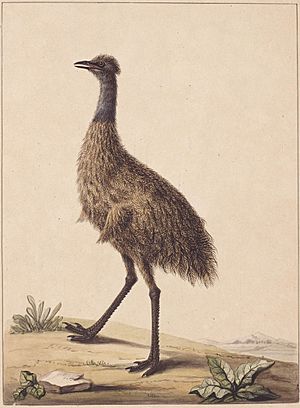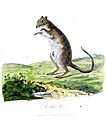Sarah Stone (artist) facts for kids
Sarah Stone (born around 1760, died 1844), also known as Sarah Smith, was a very talented British artist. She was famous for drawing and painting animals and plants, especially those brought back from exciting trips to places like Australia and the Pacific Ocean. Her detailed pictures are super important because they were some of the first drawings of many species. They are still valuable for science today!
Contents
Sarah Stone's Art and Work
A Talented Artist
Sarah Stone started her art career around 1777 and continued until about 1820. She was a skilled draftsperson, meaning she was great at drawing. She also worked as a natural history and scientific illustrator, which means she drew plants and animals for scientific study.
In the 1770s, a man named Sir Ashton Lever hired Sarah. He wanted her to draw and paint items from his amazing collection, called the Leverian Museum. This museum had many cool specimens brought back from British trips to Australia, the Americas, Africa, and the Far East in the 1780s and 1790s.
Sarah also showed her art at the Royal Academy of Arts in London in 1781, 1785, and 1786. She was an "Honorary Exhibitor," which was a special way to show her work.
Drawing New Discoveries
Between 1789 and 1790, Sarah created many watercolor paintings of specimens sent by John White. He was the first main doctor in the new British colony in Australia. These paintings were later used to make pictures for White's book, A Journal of a Voyage to New South Wales (published in 1790).
It was sometimes tricky for Sarah to draw these animals perfectly. She often worked from animal skins that had been sent from Australia and then put back together by a taxidermist in London. This meant she was drawing animals she had never seen alive! Even so, her drawings were beautiful and very skillful.
Where Her Art Is Today
Sarah Stone made over a thousand watercolor paintings based on specimens from the Leverian Museum. When the museum's items were sold in 1806, her paintings were also spread out. Some of her artworks are now at the Natural History Museum in London. Others are in private collections. Her paintings are very helpful for scientists trying to understand some species described by J.F. Gmelin, especially when the original specimens are now missing.
You can find Sarah Stone's work in several important places. The British Museum and the Victoria Gallery and Museum at the University of Liverpool in Great Britain have some of her art. In Australia, her work is held by the National Library of Australia and the State Library of New South Wales.
Sarah Stone's Family Life
On September 8, 1789, Sarah Stone married John Langdale Smith. After her marriage, she became known as Sarah Smith.
Gallery
Images by Sarah Stone - A journal of a voyage to New South Wales.





